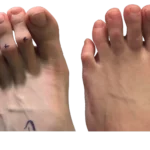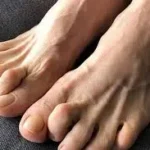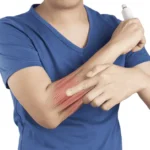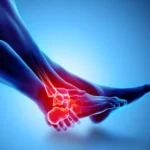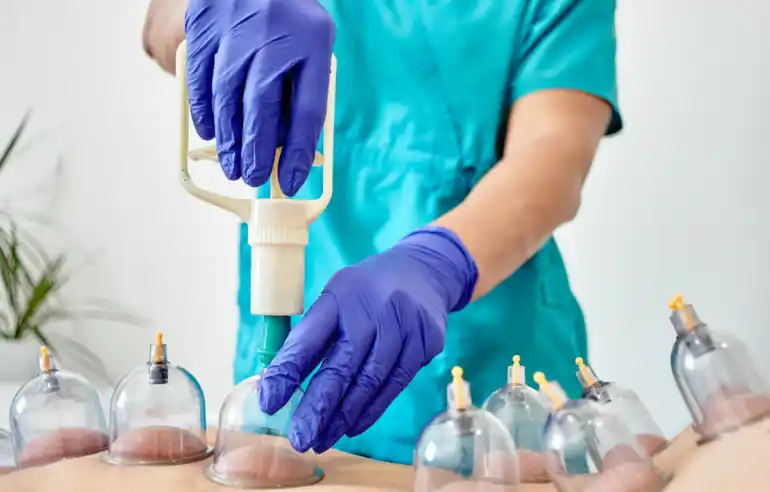Overview
The Achilles tendon is one of the strongest tendons in the human body, connecting the calf muscles (gastrocnemius and soleus) to the heel bone (calcaneus). To reduce friction between the tendon and surrounding structures, several small fluid-filled sacs known as bursae are present. When one of these bursae becomes inflamed, the condition is called bursitis.
Subtendinous Achilles bursitis specifically refers to inflammation of the bursa located beneath the Achilles tendon, between the tendon and the calcaneus. This deeper bursa acts as a cushion, allowing smooth movement of the tendon during walking, running, or jumping. When it becomes irritated or inflamed, it leads to heel pain, swelling, and stiffness that can significantly affect daily and athletic activities.
At DMPhysios, a leading physiotherapy clinic in Noida specializing in spine and sports conditions with patient-centered rehabilitation, the condition of Subtendinous Achilles bursitis is managed with a comprehensive, evidence-based approach combining manual therapy, advanced modalities, and corrective exercises.
Symptoms
The symptoms of Subtendinous Achilles bursitis often develop gradually and may worsen with continuous activity. Common signs include:
- Deep Heel Pain – Usually felt just above the heel, under the Achilles tendon. The pain increases when standing on tiptoes or during push-off while walking or running.
- Swelling and Warmth – Mild to moderate swelling may be visible around the back of the heel.
- Tenderness on Palpation – The area feels sore when pressed, especially under the tendon insertion.
- Stiffness in the Morning – Similar to Achilles tendinopathy, morning stiffness and tightness in the calf are common.
- Pain During Activity – Aggravated by climbing stairs, running uphill, or wearing tight shoes that press on the heel.
- Reduced Ankle Mobility – In severe cases, inflammation limits the range of motion in the ankle joint.
If left untreated, Subtendinous Achilles bursitis may coexist with retrocalcaneal bursitis or Achilles tendinitis, making the condition more complex and painful.
Types of Achilles Bursitis
Although the term “Achilles bursitis” covers a few variations, two main types are recognized:
- Retrocalcaneal Bursitis – Inflammation of the bursa between the Achilles tendon and the heel bone (superficial to the calcaneus).
- Subtendinous Achilles Bursitis – A deeper inflammation beneath the tendon itself, affecting the subtendinous bursa.
The Subtendinous Achilles bursitis type is less common but often more painful due to its proximity to the tendon insertion and its involvement in every step and movement of the ankle.
Causes
Several mechanical, structural, and external factors can lead to Subtendinous Achilles bursitis:
- Repetitive Strain or Overuse – Continuous activities such as running, jumping, or walking long distances overload the bursa and Achilles tendon.
- Improper Footwear – Shoes with hard backs, inadequate cushioning, or high heels can cause friction and pressure at the heel.
- Tight Calf Muscles – Limited flexibility in the gastrocnemius or soleus increases stress on the Achilles tendon and its underlying bursa.
- Sudden Increase in Activity – Rapid training progression or return to sport after inactivity may inflame the subtendinous bursa.
- Structural Abnormalities – Flat feet, high arches, or leg length discrepancy can alter biomechanics and irritate the Achilles complex.
- Direct Trauma – A direct blow or repeated compression at the back of the heel can trigger inflammation.
- Systemic Conditions – Rheumatoid arthritis, gout, or infections can contribute to secondary bursitis.
At DMPhysios, detailed biomechanical and postural assessments are carried out to identify the root cause behind Subtendinous Achilles bursitis, ensuring that the rehabilitation plan targets both pain relief and movement correction.
Risk Factors
Certain individuals are at higher risk of developing Subtendinous Achilles bursitis, including:
- Athletes involved in running, sprinting, or jumping sports.
- Dancers and gymnasts performing repetitive plantarflexion.
- Middle-aged recreational exercisers with reduced flexibility.
- People wearing ill-fitting footwear or high heels regularly.
- Individuals with tight calf muscles or biomechanical imbalances.
- Those with inflammatory diseases like rheumatoid arthritis or gout.
Understanding these risk factors allows physiotherapists at DMPhysios (Noida) to provide preventive strategies and tailor interventions for each patient.
Diagnosis
Diagnosis of Subtendinous Achilles bursitis is primarily clinical but can be confirmed through imaging:
- Clinical Examination – Includes palpation of the heel, range of motion testing, and identification of pain sites.
- Ultrasound – Reveals fluid accumulation beneath the Achilles tendon and helps distinguish bursitis from tendinopathy.
- MRI – Used in chronic or severe cases to visualize inflammation, tendon thickening, or concurrent pathology.
Early and accurate diagnosis at DMPhysios helps initiate timely treatment, reducing recovery time and preventing chronic complications.
Treatment
Treatment focuses on reducing inflammation, relieving pain, and restoring function. A multidisciplinary approach is often required:
1. Rest and Activity Modification
Avoid aggravating activities such as running, jumping, or climbing stairs. Switching to low-impact exercises like swimming or cycling helps maintain fitness without stressing the Achilles.
2. Ice Therapy
Applying ice packs for 15–20 minutes several times a day reduces swelling and inflammation in the subtendinous region.
3. Medications
Non-steroidal anti-inflammatory drugs (NSAIDs) may be prescribed to reduce pain and inflammation. In rare, severe cases, corticosteroid injections may be used, but these are administered cautiously to avoid tendon damage.
4. Footwear Correction
Using cushioned shoes or heel lifts helps reduce direct pressure on the Achilles tendon and the subtendinous bursa.
5. Orthotics
Custom orthotic inserts can help correct biomechanical faults like overpronation or flat feet, reducing the strain on the Achilles tendon.
6. Physiotherapy
The cornerstone of recovery, detailed below.
Physiotherapy Treatment
At DMPhysios, physiotherapy for Subtendinous Achilles bursitis follows a patient-centered, progressive rehabilitation protocol. The goal is not only to relieve pain but to restore strength, flexibility, and function while preventing recurrence.
1. Acute Phase (Pain and Inflammation Control)
- Rest and Protection: Avoid loading the tendon; use heel lifts or soft cushioning.
- Cryotherapy: Ice massage or cold packs to control inflammation.
- Ultrasound Therapy: Promotes healing and reduces swelling around the bursa.
- Taping or Kinesio Taping: Reduces strain on the Achilles and corrects alignment.
- Manual Therapy: Gentle soft tissue mobilization around the calf and heel to reduce tightness.
2. Subacute Phase (Flexibility and Mobility Restoration)
- Calf Stretching: Gentle gastrocnemius and soleus stretches help reduce tension on the tendon.
Example: Wall calf stretch (3 sets of 30 seconds, several times daily). - Ankle Mobilizations: Performed by physiotherapists to improve dorsiflexion.
- Soft Tissue Release: Myofascial release around the Achilles and plantar fascia enhances tissue elasticity.
3. Strengthening Phase
Once pain subsides, strengthening exercises are introduced:
- Isometric Heel Raises: Performed without pain to reintroduce tendon loading.
- Eccentric Calf Raises: Gradually strengthens the tendon and surrounding structures (a proven exercise in Achilles rehabilitation).
- Resistance Band Exercises: To enhance ankle stability and calf strength.
- Proprioceptive Training: Using balance boards or single-leg stance exercises to improve joint control.
4. Functional and Return-to-Sport Phase
The final stage aims to restore full function and prevent recurrence.
- Plyometric Drills: Low-impact hops and bounding exercises once pain-free.
- Sport-Specific Drills: Gradual reintroduction to running, sprinting, or jumping activities under supervision.
- Gait Re-education: Addressing faulty movement patterns that may have contributed to bursitis.
At DMPhysios, every rehabilitation program for Subtendinous Achilles bursitis is customized according to the patient’s condition, sport, and activity level. The clinic’s advanced facilities and expert team ensure a safe and efficient recovery pathway.
Prevention
Preventing Subtendinous Achilles bursitis involves maintaining healthy biomechanics, flexibility, and strength:
- Proper Warm-up and Stretching before sports or workouts.
- Gradual Training Progression – Avoid sudden increases in running distance or intensity.
- Appropriate Footwear – Use well-cushioned shoes that support your heel and arch.
- Regular Strengthening – Focus on calf, ankle, and foot intrinsic muscles.
- Maintain Flexibility – Regular stretching of the gastrocnemius, soleus, and plantar fascia.
- Early Treatment of Heel Pain – Address minor symptoms promptly before they worsen.
- Postural and Biomechanical Correction – Periodic assessment at DMPhysios helps identify early abnormalities and prevent chronic overuse injuries.
Conclusion
Subtendinous Achilles bursitis is a painful but manageable condition if diagnosed early and treated with the right combination of rest, medical care, and physiotherapy. Left untreated, it can lead to chronic pain, limited mobility, or secondary tendon involvement.
At DMPhysios, a renowned Noida-based clinic specializing in spine and sports conditions with a patient-centered rehabilitation approach, expert physiotherapists provide personalized care for conditions like Subtendinous Achilles bursitis. Their holistic rehabilitation programs focus on pain relief, mobility restoration, and long-term prevention, helping patients return to pain-free, active living.
If you’re experiencing persistent heel pain or suspect Subtendinous Achilles bursitis, don’t ignore the symptoms. Visit DMPhysios today for an expert assessment and individualized physiotherapy care designed to get you back on your feet stronger than before.



